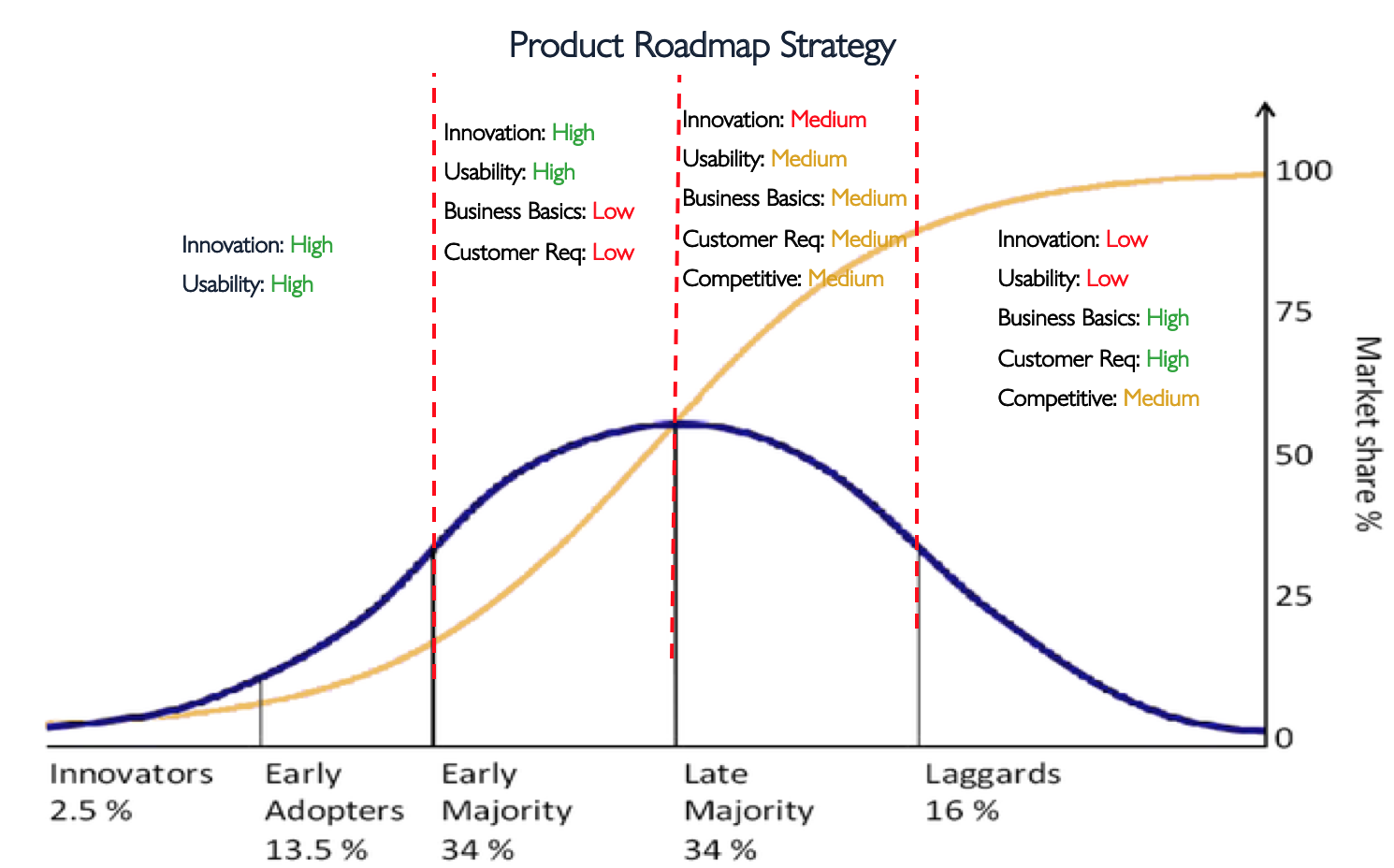If you haven’t already seen the talk by Adam Nash on product planning, then I’d highly recommend giving it a watch. One of the concepts Adam touches on is the 3 buckets of focus that features fall into when developing a product roadmap, namely Metric Movers, Customer Requests and Customer Delight. As a product leader you are familiar with these buckets or focus areas but maybe you call them by a different name.
I personally look at features as falling into one of these buckets when building out a product roadmap –
- Improve usability – Improving the UI and accessibility of the product and features
- Business basics – Fixing bugs and design defects, paying back tech debt, etc
- Customer requests – These are requests from your existing customer base
- Innovation – Adding new capability that can leapfrog existing technology, solving a huge pain point in a better more efficient way, etc
- Competitive – Responding to competitors who play up a feature comparison especially in a commoditized market
One of the important things when creating a roadmap strategy is to understand where we are on the product adoption curve and understand the weights we apply to each of these buckets.

Image source: https://ondigitalmarketing.com/wp-content/uploads/2012/01/640px-Diffusionofideas.png
If we look at the product adoption curve and understand the sales / market penetration we find that market penetration increases exponentially during the early to late majority stages, while at the innovator to early adopter stage as well as in the laggards stage the market penetration is fairly flat.
Aligning product roadmap strategy to the adoption curve
Below are some trade-offs and implications to consider while building out your roadmap at various stages of the product adoption lifecycle. I’ve also added some weights to the various buckets at various stages based on my own experience managing products in different stages of their lifecycle, but these weights will differ based on the industry, type of market you are in, whether it is B2B / B2C, etc. Given a finite amount of resources, it is important to get the right mix of features at the relevant stage of product adoption you are in.

Innovators and Early Adopters: In these stages, you need be focusing on building big innovative features and providing a great user experience. Adding tech debt is never a good thing, but based on limited resources you have, you want to focus on getting the innovative capabilities developed so you can get the innovators and early adopters to adopt your product. In addition to innovation, usability and user experience UX is key in getting the early adopters on board as well as to overcome the chasm between early adopters and early majority stages.
Focus buckets and weight: Innovation (High), Improve usability (High)
Early Majority: This stage is where you get a lot of medium sized organizations that want to use innovative products to compete with larger incumbents in their market. While Innovation and improving usability is still key buckets to focus on, you will also want to start looking at some business basics and a few customer requests to ensure you don’t have any churn or negative sentiments in your user base. This will also show your ability to respond quickly and showing your customers that you are actively listening to their feedback and suggestions which is key to getting you ready for the next stage of Late Majority that will give you a huge jump in sales / market penetration.
Focus buckets and weight: Innovation (High), Improve usability (High), Business Basics (Low), Customer Requests (Low)
Late Majority: At this stage of your product adoption lifecycle is increasing exponentially and you are looking at acquiring the majority of the market with sales to medium and large enterprises that bring with them a myriad of challenges. Customers in this stage will have concerns beyond just the features and capability and will extend into compliance issues, security controls, integrations, skillset to use the software, etc. Here, you will find that you may have to add more weight to the Customer Requests and Business Basics buckets as well as start to look at features that can head off Competitive forces while dialing down your innovation bucket. This stage is when you will be pulled in different directions as a product manager and it is crucial that you allocate your resources and focus on the right areas. The weightage below has worked on products that I’ve been responsible for in the past, but depending on the industry you are in, type of market, etc you may want to dial up certain buckets and dial down others.
Focus buckets and weight: Innovation (Medium), Improve usability (Medium), Business Basics (Medium), Customer Requests (Medium), Competitive (Medium)
Laggards: This is the final stage of the product adoption cycle and at this point you are focussed on ensuring you have no churn with your existing user base. That means you will have to ensure you are listening to feature requests, cleaning up the bugs and design defects that have had work arounds and also ensuring you are keeping competitive forces at bay.
Focus buckets and weight: Innovation (Low), Improve usability (Low), Business Basics (High), Customer Requests (High), Competitive (Medium)
Looking at where you are in the product adoption lifecycle and market penetration is just one variable that influences how you allocate resources and build your product roadmap. In reality there are many variables and inputs to consider when building your product roadmap.
